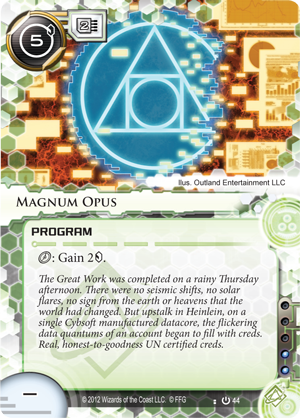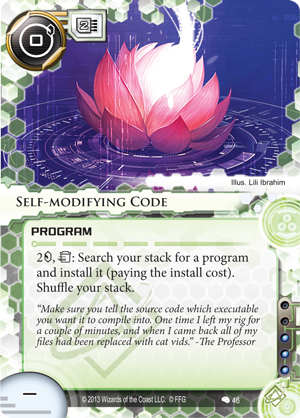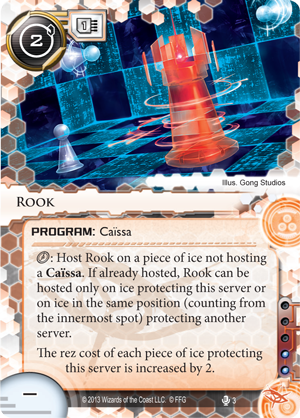
Building Your Rig
An Android: Netrunner Strategy Article by 2013 World Champion Jens Erickson

Everything you know is a lie.
The world you inhabit? The reality you think you know? They’re just constructs the Corps have built. The things you hear or see or think? They’re what the corps want you to hear or see or think. If you want some glimpse of the truth, you have to hack through layers of firewalls, past sentries, barriers, and the pervasive media chatter.
Megacorps would have you believe that they’re built on dreams and hopes. But they’re not. They’re built on credits, lies, and the blood and sweat of the little guys who can’t stand up for themselves. They will kill whomever they need, whenever they can, to keep their messaging strong and clear, blazing from Broadcast Square to outer space.
You want truth? Talk to a runner. They call us criminals, sure, but that’s just because megacorps don’t live by laws; they make them. They make reality. But whatever they think they can make, runners like me can tear it down. And once you tear away the veil, there’s only one real truth: the network. The network is everywhere. Everything is on the net. Your banking, your purchase history, your favorite shows, your dirty laundry. You dig deep enough, you run fast enough, you can find anything, and be anyone…

2013 World Champion Jens Erickson on Building a Runner Deck
Among the parts of Android: Netrunner that I like most, the game’s asymmetry ranks highly. Corp and Runner play styles vary in wild degrees, and while that holds true in many ways through deck-building, they also share some interesting similarities.
In an earlier article, I walked you through my Corp deck-building process, and I want to walk you through my deck-building process again today, but this time looking at the Criminal side of things. For some time now, I’ve been enjoying an interesting spin on Andromeda (Humanity’s Shadow, 83) that began as a skeleton and has fleshed out splendidly.
Build with Purpose
 The Runner’s vision statement is much the same as it was for the Corp. You have to start by asking yourself, “What does your deck do?” This the first question you ask yourself when you start building a deck, and the answer guides every step along the way.
The Runner’s vision statement is much the same as it was for the Corp. You have to start by asking yourself, “What does your deck do?” This the first question you ask yourself when you start building a deck, and the answer guides every step along the way.
There is, however, a major difference in how the ensuing process plays out. Where the Corp is asking how it’s going to defend and score points, the Runner’s determining how he’s going to disrupt the Corp and where he intends to access cards. These are the most important concerns to address. Unless you plan to deck the Corp, your Runner simply cannot win without accessing and stealing seven agenda points.
The most common method of focusing access is through the use of multi-access cards such as R&D Interface (Future Proof, 107), Medium (Core Set, 10), and The Maker’s Eye (Core Set, 36). However, these are absolutely not the Runner’s only options. Criminal decks can operate with tremendous pressure, running on every gap the Corp leaves, and, given enough time, Noise (Core Set, 1) can score all seven points in one epic run on Archives.
Another concern is your timing, when you plan on accessing Corp cards, and how you can pace the game to reach that position or stay in it. Are you using Magnum Opus (Core Set, 44) to power Self-Modifying Code (Creation and Control, 46) and building a full rig as fast as possible?
Or are you utilizing Reina Roja (Mala Tempora, 41), Rook (Opening Moves, 3), and Xanadu (Humanity’s Shadow, 82) to keep the Corp poor and undefended?
The plan I’m going to walk you through, here, uses Andromeda (a common face at any event) and focuses on the disruptive powers of The Source (Creation and Control, 55) and how that shapes the deck.
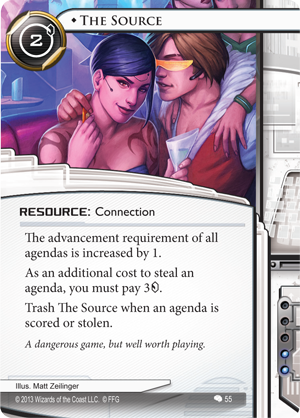 The Source is one of the very few neutral cards with an influence cost, and its effect completely shifts how the Corp acts. And once you control how your opponent acts, you gain the advantage, forcing him into plays he wouldn’t otherwise make. With The Source in play, a Haas-Bioroid player cannot use Biotic Labor (Core Set, 59) to install, advance, and score agendas directly from HQ. Furthermore, agendas such as Government Contracts (A Study in Static, 77) now take three turns to score. Knowing this, we find two avenues opening before us: We can attack an agenda as the Corp attempts to score it, or we can use an HQ Interface (Humanity’s Shadow, 85) attack the Corp’s HQ, where it’s going to store the agendas it’s having difficulty advancing and storing.
The Source is one of the very few neutral cards with an influence cost, and its effect completely shifts how the Corp acts. And once you control how your opponent acts, you gain the advantage, forcing him into plays he wouldn’t otherwise make. With The Source in play, a Haas-Bioroid player cannot use Biotic Labor (Core Set, 59) to install, advance, and score agendas directly from HQ. Furthermore, agendas such as Government Contracts (A Study in Static, 77) now take three turns to score. Knowing this, we find two avenues opening before us: We can attack an agenda as the Corp attempts to score it, or we can use an HQ Interface (Humanity’s Shadow, 85) attack the Corp’s HQ, where it’s going to store the agendas it’s having difficulty advancing and storing.
The recent release of Fall Guy (Double Time, 106) gives us another huge advantage, as well, since it allows us to avoid trashing The Source whenever an Agenda is scored. Additionally, Hostage (Opening Moves, 4) gives us the means to search for The Source and other connections, providing a welcome consistency that we’ll use more further down the line.
Breaking the ICE
Just as assembling a coherent variety of ice is one of the most important tasks the Corp faces in deck-building, assembling your icebreaker suite is one of the most important steps in building your Runner deck. Icebreakers are vitally important, as without them you are extremely limited in your options. Even with a high line of credit from Kati Jones (Humanity’s Shadow, 91) or Liberated Account (Trace Amount, 22), a Runner without an icebreaker suite will find his or her options extremely limited. In fact, a Runner without icebreakers or bypass effects is going to find himself swiftly and completely shut out of the game.
Here are a couple useful guidelines to consider while choosing your icebreakers:
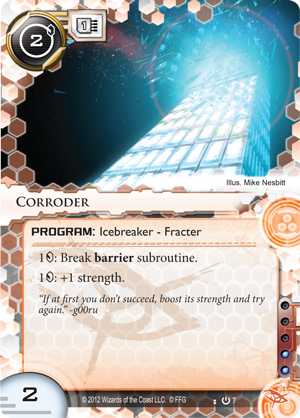 Be willing to spend your influence. Outside of any cards that are instrumental to your vision statement, there’s no better place to spend your valuable influence. The savings you’ll get from playing Corroder (Core Set, 7) over Aurora (Core Set, 25) or Snowball (Trace Amount, 27) are well worth the influence.
Be willing to spend your influence. Outside of any cards that are instrumental to your vision statement, there’s no better place to spend your valuable influence. The savings you’ll get from playing Corroder (Core Set, 7) over Aurora (Core Set, 25) or Snowball (Trace Amount, 27) are well worth the influence. - Play breakers that fit your vision statement. If you plan on running early and often, Garrote (True Colors, 65) or Torch (Mala Tempora, 47) are going to be too slow. On the other hand, they fit perfectly into a late-game deck running against R&D with Chaos Theory (Cyber Exodus, 46).
- Be prepared for everything, and have multiple plans for any situation. If a Corporate Troubleshooter (Core Set, 65) powers up a Rototurret (Core Set, 64) enough to kill your Mimic (Core Set, 11), do you have another way around sentries? Duplicates and AI icebreakers fill this roll nicely.
Powered by The Source, Andromeda wants to be aggressive and run on remote servers with pinpoint precision, entering them while the Corp is attempting to score in them. Even without Datasucker (Core Set, 8), the Anarch’s icebreakers, Corroder, Mimic, and Yog.0 (Core Set, 14), are the most efficient choices for this deck, allowing us access through lower strength ice at very little cost. Two copies of Knight (Mala Tempora, 43) and one copy of Femme Fatale (Core Set, 26) provide us additional options for accessing servers and dealing with larger ice that the Core Set Anarch breakers can’t touch. As additional back-up, three copies of Faerie (Future Proof, 104) safeguard us against destroyers like Grim (Opening Moves, 20) and a sudden, retaliatory strike from Power Shutdown (Mala Tempora, 58).
Beyond the deck’s icebreakers, there are a couple other important cards that need to be addressed in this section, the most important of which is Inside Job (Core Set, 21). Along with Knight, Inside Job can provide us access even when the Corp thinks, “There’s no possible way Andromeda can get into this server.” Special Order (Core Set, 22) also fits into this section; like Hostage, it’s around to increase consistency, as I know I’ve had games without Special Order where I couldn’t find my Corroder for turn after turn.
Get Paid
While comparing the Corp and Runner sides of the game, many players fall into the common trap that treats their use of credits as equivalent. This thought has completely rational origins, especially when Sure Gamble (Core Set, 50) looks so much like Hedge Fund (Core Set, 110). The difference, though, lies in the fact that while the Corp only has to pay one for a piece of ice, the Runner needs to pay each time he encounters it, meaning the Runner needs to gain and spend credits much more often than the Corp.
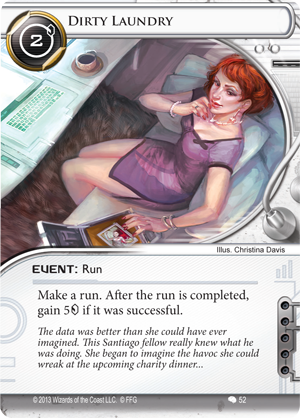 What I’m getting at here is that credits are the Runner’s lifeblood, and they need to be treated as such. You need to ask yourself how your deck will keep its income flowing, and you need to build around that idea. Noise might keep visiting Aesop’s Pawnshop (Core Set, 47) while Kate “Mac” McCaffrey (Core Set, 33) uses her Magnum Opus to stay in the black. The important thing to consider is how your deck operates and what its needs are, and to slot your economy accordingly.
What I’m getting at here is that credits are the Runner’s lifeblood, and they need to be treated as such. You need to ask yourself how your deck will keep its income flowing, and you need to build around that idea. Noise might keep visiting Aesop’s Pawnshop (Core Set, 47) while Kate “Mac” McCaffrey (Core Set, 33) uses her Magnum Opus to stay in the black. The important thing to consider is how your deck operates and what its needs are, and to slot your economy accordingly.
Back to Andromeda, there are three major concerns driving the shape of her economy. First, her nine-card opening hand means she wants the ability to generate credits in bursts with cards like Dirty Laundry (Creation and Control, 52) and Sure Gamble, so that she can play out four cards on turn one. Second, the inclusion of Hostage means that powerful connections such as Kati Jones and Professional Contacts (Creation and Control, 49) fit perfectly into the deck. Finally, Criminal decks are quite event heavy, and this deck is no exception. Because most of these events are run events, like Account Siphon (Core Set, 18), we’ll include Desperado (Core Set, 24) to reward our aggressive running, and the inclusion of all our run events also means that consistent card draw is of high importance.
Plan to Counteract the Corp’s Designs
The last thing I do when deck-building is to look at my opponent, the Corp. Earlier I mentioned that you can control a game by forcing your opponents into lines of play with which they are unfamiliar. This, however, implies familiarity with the Corp’s normal plans and with some means of counteracting them. Sometimes, however, even an intimate knowledge of your opponent’s normal plans won’t provide you any means of disrupting them, and this is a weakpoint to watch for during deck-building.
A very common example of shoring up your weakpoints is the inclusion of Plascrete Carapace (What Lies Ahead, 9) as an answer to Scorched Earth (Core Set, 99) and Punitive Counterstrike (True Colors, 79). While you don’t need to include counters to all possible strategies, some will still demand your respect as you build a deck. Then, as I mentioned during my article on Corp deck-building, theory is only half the battle; testing your deck against a variety of Corp decks will give you a much better idea of which Corp designs should worry you the most.
In our Andromeda deck, two cards made their way into the list as counters to specific Corp strategies. Plascrete Carapace is the first, as we want to be sure the Corp is on the “Agenda” plan and not the “firing missiles” plan. The other is Emergency Shutdown (Cyber Exodus, 43), a much more versatile card that can drain the Corp’s resources, but that also plays an important part in countering Archer (Core Set, 101) and other large ice that our favored breakers cannot break.
Andromeda: Displaced Ristie
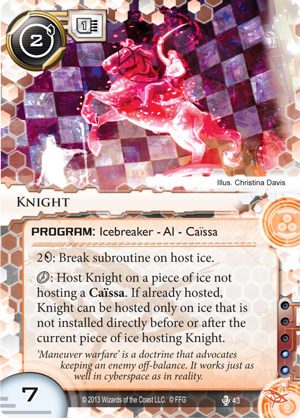 Programs (9):
Programs (9):
1x Corroder **
3x Faerie
1x Femme Fatale
2x Knight **
1x Mimic *
1x Yog.0 *
Resources (8):
3x Fall Guy
2x Kati Jones
1x Professional Contacts **
2x The Source **
Hardware (7):
3x Desperado
2x HQ Interface
2x Plascrete Carapace
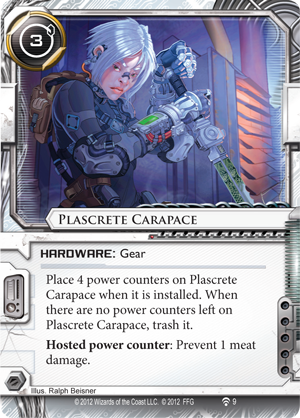 Events (21):
Events (21):
3x Sure Gamble
3x Account Siphon
3x Dirty Laundry
1x Quality Time *
3x Inside Job
3x Special Order
2x Hostage
3x Emergency Shutdown
Total Cards: 45
Build Toward the Future
Because Android: Netrunner is a Living Card Game®, deck-building is a constantly evolving process, so what does the future hold for Andromeda and The Source? Now that Honor and Profit is available, it presents a whole slew of interesting new connections for Hostage to target, including Donut Taganes (Honor and Profit, 75) and Tri-Maf Contact (Honor and Profit, 50), and it also presents some interesting icebreakers like Overmind (Honor and Profit, 53) that may be worth locating on Special Order.
Remember:
Have a plan, but don’t let it tunnel vision you from alternate paths in game.
Don’t skimp on your icebreaker suite. If losing one card would break your deck’s backbone, bring a backup.
Credits are king. Make sure your economy makes sense in your deck.
Playtest, playtest, playtest. Theory can go a long way, but only practice will tell you what still needs tuning.
Thanks, Jens!
As the 2013 Android: Netrunner World Champion, Jens Erickson knows a couple things about using Andromeda to good effect. Will you follow in his path? Or will you carve your own holes into the network?
Keep your eyes open for more Android: Netrunner strategy articles and other news. In the meantime, you can find more information about deck-building, game play strategies, and other topics in our community forums!
…

